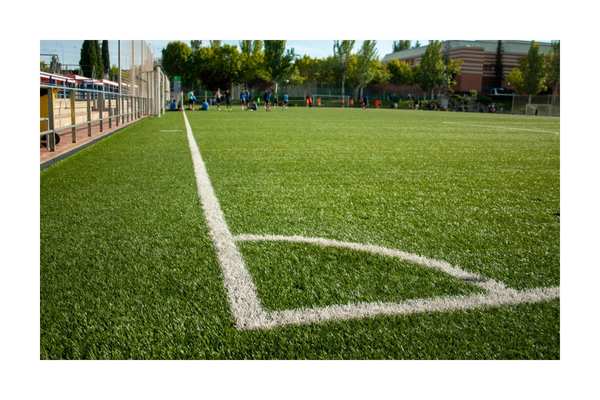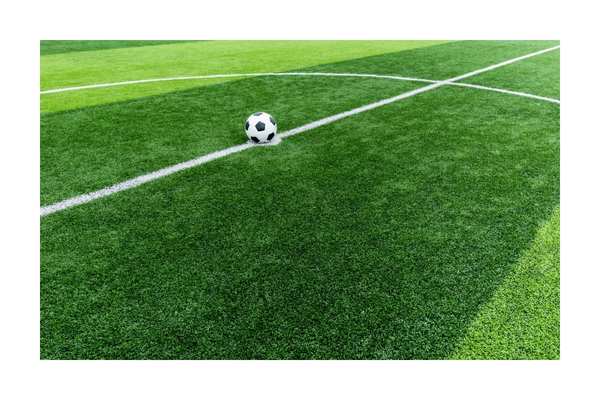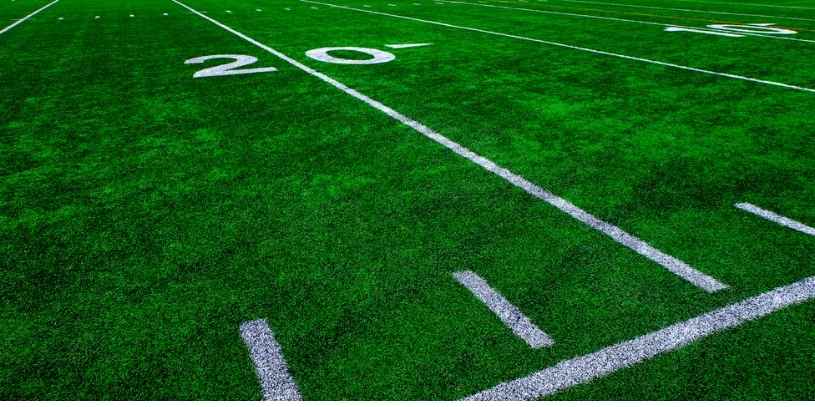Imagine a robot zipping across a football field, painting yard lines with perfect precision. There’s no crew of four with strings and measuring tapes, just one high-tech machine getting the job done. This isn’t science fiction; it’s happening now with field painting robots.
These autonomous robots (sometimes called robotic field painters or robotic line markers) are changing how sports fields are marked by making the process faster, cheaper, and incredibly accurate. Follow along to learn how these machines work and how to use them to save time and tedium.
How Do Field Painting Robots Work?
A robot field painter is a self-driving machine equipped with paint sprayers and GPS technology. The concept is similar to a household robot vacuum that maps your living room. But instead of cleaning, these robots lay down painted lines on grass or turf. Here’s how they work.
GPS Guidance
Most robotic field painters use advanced GPS for navigation. In fact, many employ RTK GPS (Real-Time Kinematic GPS), which is a high-precision system with accuracy down to a centimeter.
Typically, the grounds crew will set up a small GPS base station (receiver) on a tripod at the field to serve as a reference point. The robot then communicates with this base to know exactly where it is on the field. This GPS guidance means the robot drives along the exact coordinates of the field lines as per the dimensions input, even if the field is huge.
Field Mapping via Software
Before painting begins, a robot needs a “map” of what to paint. Operators use a tablet or software to select the field layout and dimensions. These robots come pre-programmed with templates for various sports, including football, soccer, lacrosse, rugby, athletics tracks, etc.
You simply choose the type of field and input any custom measurements (say, a soccer field measuring 100×64 meters). The robot’s software then plots the marking plan. For example, you can use an iPad with all the field types programmed. Then, select the sport and field size, press start, and watch the robot go to work.
Autonomous Navigation and Spraying
Once you set the layout and the robot knows where to go, it’s time to paint. The robot drives itself to the starting point on the field (usually one corner) and then follows the programmed path line by line.
It’s battery-powered and moves on wheels (typically three- or four-wheeled chassis). As it moves, an onboard pump and nozzle system sprays paint onto the turf. The robot maintains a consistent speed and spray pressure, which produces crisp, even lines. This consistent application can reduce paint consumption by around 50% compared to manual line painting.
 Sensors and Safety
Sensors and Safety
Field robots often have obstacle sensors. For example, if a person or dog runs across a field unexpectedly, the robot can stop to avoid a collision. They are low to the ground (often under 2 feet tall and about 70-80 lbs), so tipping or causing damage is unlikely.
Their speed is around walking pace or a bit faster, which is sufficient to cover fields quickly but not so fast that it’s dangerous. Typically, one staff member stays nearby to supervise, especially in public places. They can use a remote control or tablet to pause or stop the robot if needed.
Memory for Remarking
One neat feature of these robots is that they remember field markings. Once a field’s initial marking is done and saved, the next time is even easier. For repainting faded lines, the robot follows the exact same tracks it did before.
This means no need to measure again each week. As long as the robot’s starting reference is consistent, it will redo the lines precisely where they were, which results in professional-quality, crisp lines every time.
Where Can I Use Field Painting Robots?
Robotic line painters are versatile and can be used almost anywhere sports or game fields need lining. Here are some settings and organizations that are using (or can benefit from) these innovative machines:
Local Parks and Recreation Departments
City and county parks departments often maintain dozens of fields for soccer, baseball, football, etc. Many are finding that robots can ease the burden on their small grounds crews. This helps take the load off employees and allows them to focus on more important responsibilities. So in your local community park, that perfectly lined soccer field on Saturday morning might just be courtesy of a robot that did the work earlier in the week!
School Districts (Middle Schools/High Schools)
Schools have multiple sports, all requiring markings. Robots are a great solution for school districts that maintain many fields across different campuses. For example, Hurst-Euless-Bedford ISD in Texas nicknamed their Turf Tank robot “Hank” and use it to line all their school sports fields.
They found they could set up a football field in about 45 minutes with one person, even on short notice, which was revolutionary for them.
Colleges and Universities
Many major universities have adopted field painting robots for their athletic departments, including at big-name colleges such as LSU. Colleges often have multiple sports complexes and practice fields, so a robot ensures all those fields are kept game-ready with less labor.
For example, a college might have their football practice fields, game stadium, intramural fields, and soccer or lacrosse fields. A robot can handle all of those with different templates loaded in.
Professional Sports Teams and Stadiums
At the pro level, these robots are making inroads too. Large NFL stadiums such as Raymond James Stadium have used Turf Tank robots for field marking. These organizations have the resources for large crews, but they still appreciate the precision and efficiency of a football field painting robot.
Youth Sports Clubs and Facilities
Private soccer clubs, rugby clubs, and sports complexes that host a lot of youth leagues can benefit too. Many such clubs operate on tight budgets with volunteer help. Investing in a soccer field painting robot can pay off by reducing the need for weekly volunteer labor.
 What Are the Benefits of Using a Field Painting Robot?
What Are the Benefits of Using a Field Painting Robot?
Thinking about getting a robotic line painter? Here’s how investing in one can benefit you:
- Save hours, paint in minutes: What used to a be a long, tedious job can now be done within minutes, not hours (depending on the field size). That means faster turnarounds, more time for touch-ups, and less stress over tight schedules or unexpected weather delays.
- Less labor, more efficiency: No need to gather a full team just to mark a field. A single operator can set up and oversee the robot while focusing on other tasks. This helps you deal with staffing shortages and takes the hassle out of field prep.
- Cut paint costs in half: Precision matters. By using only the exact amount of paint needed, field marking robots reduce paint usage and save you money. Plus, less paint is better for the environment.
- Perfect lines, every time: No more wavy or crooked lines. GPS-guided accuracy ensures crisp, professional markings with every pass. Your field will always look sharp and competition-ready.
- Free up your staff: Instead of spending hours pushing a paint machine, your crew can focus on other maintenance. The robot takes care of the tedious work, helping you get more done without stretching your team too thin.
- One robot, multiple sports: Switching from soccer to football? Need to repaint a lacrosse field? No problem. A field painting robot can handle multiple layouts or make last-minute changes.
What Are Some Examples of Field Painting Robots on the Market?
Several companies have developed robotic field painters, each with their own features and strengths. Here are a few leading examples ofthe most notable machines on the market:
Turf Tank One
Turf Tank’s GPS-guided robot is known for its user-friendly interface and precision. It can paint a soccer field in just 25 minutes using only one gallon of paint. Major universities, professional teams, and parks departments praise its efficiency. It’s no wonder it earned the nickname “Hank the Tank.”
SWOZI Cart Pro & Pico
Swiss-engineered SWOZI offers a versatile system that operates in push, ride-on, or fully autonomous modes. It delivers perfectly marked fields in 20 minutes, with a budget-friendly Pico model for smaller clubs. The Stealth Striper even combines mowing and painting in one pass.
TinyMobileRobots (TinyLineMarker)
TinyMobileRobots’ devices utilize satellite communication and Real-Time Kinematic networks to achieve precise line marking on sports fields. In addition to sports fields, these robots paint road marking, with a stronger presence in Europe and the U.K. compared to Turf Tank’s U.S. dominance.
Looking for the Perfect Robotic Solution for Your Home, Business, or Property? AOS Can Help!
Why spend hours maintaining your property when a robot can do it for you? At Automated Outdoor Solutions, we bring you the latest in hands-free technology, so you can enjoy a perfectly maintained home or business without lifting a finger.
Let smart automation handle the hard work while you focus on other tasks. Ready to reclaim your time? Check out our online shop and get in touch today to explore your options for effortless outdoor maintenance.

